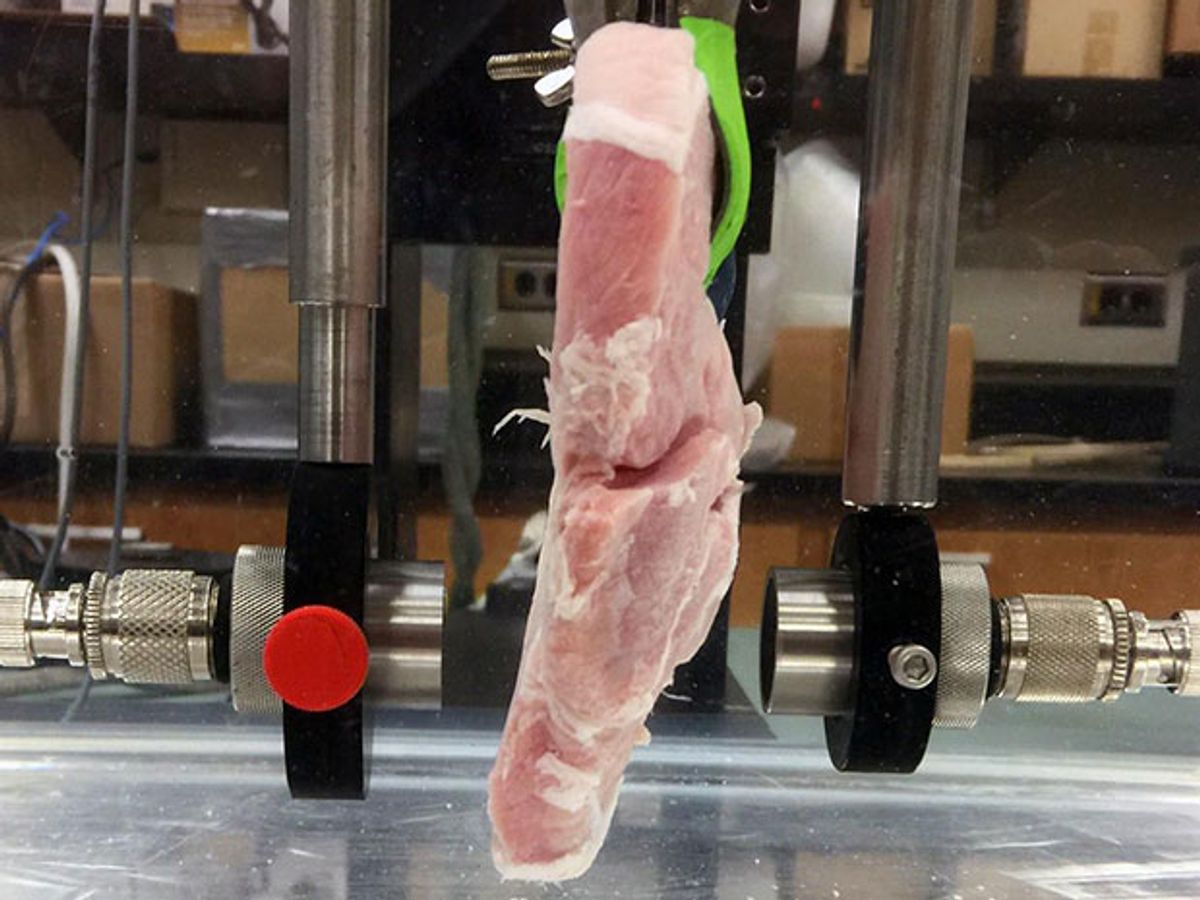Modern medical implants are hobbled by slow download speeds. Most medical devices transmit data over radio frequencies at the relatively glacial pace of fewer than 50 kilobytes per second. At that rate, it can take ages for physicians to transfer data or reprogram devices.
New evidence suggests ultrasonic signals could speed up that process. Researchers who achieved higher data rates in one early test say that these signals may eventually enable doctors to live stream high-quality video from inside of a patient.
A team led by Andrew Singer, an electrical engineer at the University of Illinois at Urbana Champaign, found that they could use ultrasonic signals to transfer data through meat at speeds up to 30 megabits per second. That’s the highest ever recorded data rate for signals transmitted through animal tissue, Singer says. For comparison, streaming Netflix in Ultra HD requires 25 megabits per second.
Most implants installed today broadcast on radio frequencies. But those signals must remain below a maximum bandwidth of 300 kilohertz. More powerful signals might cause the resulting electromagnetic waves to interfere with nearby devices. They could also harm patients, since the body absorbs some waves as the signals pass through. Or as Singer puts it, “We are a bag of salt water, and electromagnetic waves heat up salt water.”
In addition to being dangerous, this absorption also makes data transfer quite inefficient. Singer wanted to use ultrasonic signals to transmit data at higher rates and keep more of it intact along the way.
Before he could begin his experiment, Singer had to pick up some pork loin and beef liver from County Market in Champaign, Ill. He threw some pig knuckles in the shopping bag, too because he thought it might be neat to try to transmit wireless signals through bone and gristle.
Back at his lab, colleagues rejected the pig knuckles. But the remaining slabs were carefully strung, one at a time, between two 5-megahertz transducers in a tank filled with water. One transducer converted binary digital data to ultrasonic signals that were transmitted through the meat. Its twin measured the resulting data rates.
Singer was happy to see that, in addition to the signal traveling fast, most of the original data arrived intact, with little lost during its journey through the meat. “We were a little bit surprised that the meat really did not provide much in terms of additional dispersion or attenuation,” Singer says. “The signals coupled extremely well and we had almost the entire bandwidth available to us for data transmission.”
Jeremy Dahl, a radiologist at Stanford University who focuses on ultrasonic devices, points out that the transducers in Singer’s study were positioned only 5.86 centimeters apart, with the meat in the middle. Therefore, it’s not clear that medical devices embedded deep in the body could achieve similar rates while transmitting to, for example, a physician’s kiosk across the room.
And since they didn’t test the pig knuckles, Singer’s group still doesn’t know how ultrasonic signals will stack up as a method of data transmission when when signals have to travel through bone or skin.
Another potential issue is that ultrasonic signals travel in a beam instead of broadcasting in all directions at once. A physician would have to know how a device is oriented within a patient’s body in order to catch the signal it emits.
“If you’re trying to receive from a different location from where that beam is directed, you’re not going to receive any signal,” Dahl says. Radio frequency is omnidirectional, so an external device can capture it from any direction.
Next, Singer hopes to pursue animal studies. In the future, he thinks higher data rates achieved through ultrasonic signals could allow physicians to ask a patient to swallow a camera and watch a live stream as it passes through the digestive tract.
Or, it might enable practical functions that have so far eluded the medical device industry, such as making software upgrades to devices that are already in place. “At today's rates for communicating with implantable devices, you'd never even consider the possibility to change the software on these things,” Singer says.



